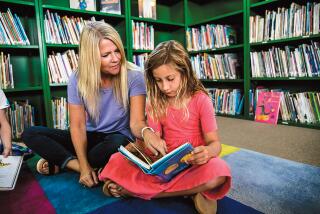READING: THE ABCs of helping youngsters...
- Share via
Here’s a fun idea: Play a game, learn to read.
Teachers who once relied on drills and work sheets for reading lessons are now supplementing their traditional classroom tools with toys and games that teach phonics and other skills.
Consider the Phonics Desk: As a child pushes down on each of the brightly colored plastic letters on the desktop, the letters say their names.
Or how about the Phonics Game, which offers a series of interactive card games that cover a different set of phonics rules.
Many teachers say such games can be useful for children who need an extra boost with learning the basic skills of reading.
“When it’s a game, the kids love it. . . . It’s like offering them chocolate,” said Tammi Rainville, who coordinates services for disadvantaged students at Limerick Avenue Elementary School in Canoga Park. “They’re sounding out, they’re reading, they’re doing a lot of skills.
“When something is done in the guise of a game, it sounds a lot better than, ‘Let’s pull out our workbooks,’ ” she added.
Many of the products being offered to parents and teachers this year use video and audio tapes, CD-ROMs and microelectronic technology to entice children to read.
“They make it look like a toy, but they’re instructional games,” said Cecelia Manley, principal of Adelanto Academy of Math and Science near Victorville.
“Students at this time in history are so video game connected. They’re more attracted to bright colors and stimulus. That’s where these come into the educational setting,” she said.
“It does motivate kids. It definitely benefits them in their learning. We can see it in the way they respond, in their attentiveness,” she added.
But not everyone is convinced that the increased use of games and toys by teachers is a good thing.
“I get concerned when [fun] is the standard to use to determine what children are doing in the classroom,” said Laurie MacGillivray, associate professor at USC’s Rossier School of Education. “Fun isn’t a standard I look to very often.
“Having quick games reinforces our ‘Nintendo society.’ I don’t want the schools to reinforce that mind-set. I’d much rather have a child reading a book,” she said.
But the intersection of education and commercialism seems unstoppable.
An army of entrepreneurs is tapping the growing market, rushing to produce educational games and toys at a breakneck pace.
One of the newest entrants in the field is LeapFrog Toys, founded in 1995 by a San Francisco attorney who was frustrated with what he saw as the limitations of teaching his son phonetic sounds with a ‘mute’ wooden alphabet puzzle.
The company produces the Phonics Desk.
The desk allows children to assemble words by using accompanying “talking phonics cards.” Children press down on the letters and hear the phonetic sounds and words.
This summer, the State Board of Education voted to allow school districts to purchase LeapFrog products if local educators choose to.
“We’ve had explosive growth,” said Robert Lally, president of LeapFrog SchoolHouse, the company’s educational division.
LeapFrog also makes “LeapPad,” an interactive electronic book that teaches children to sound out and spell words through stories.
“We think children learn when things are interactive, when things are multi-sensory. Those two things make kids more engaged. It enhances the process for all kids and gives them multiple channels to learn,” he said.
Barbara Meserve, director of education at Games2Learn, makers of the Phonics Game, agrees.
The Phonics Game uses video and audio tapes to augment the card games, as well as audio spelling lessons and phonetic rules cards. An upgraded version includes a CD-ROM supplemental program.
“We believe that children learn best when they’re having a good time,” Meserve said.
“Generally, parents are looking for substance. They don’t want another stuffed animal, but want things that really encourage learning, [and] they’re looking for something their kids will enjoy,” she said.
The varied games and toys can cost as little as $20 but as much as several hundred dollars, and some experts question whether the money is well spent.
MacGillivray, the USC professor, believes that families might do better--and children might learn reading in a more authentic manner--if they simply spent the money on good books and other reading materials for the home.
“We have to be really clear about what we’re saying to parents, especially parents on a tighter budget,” she said.
SOUTHERN CALIFORNIA LIVING: Several books featuring dancers and dancing celebrate diversity and inspire young readers too. E6






